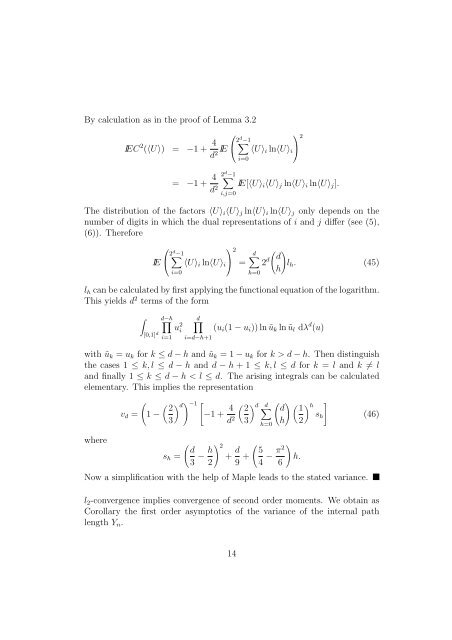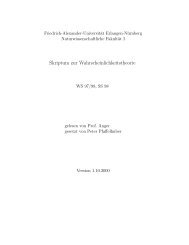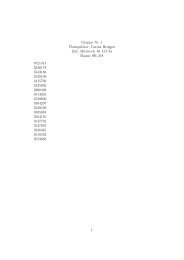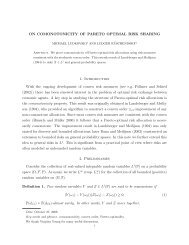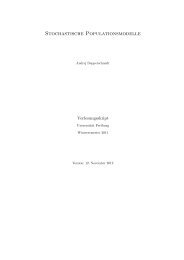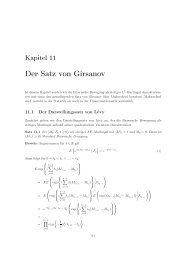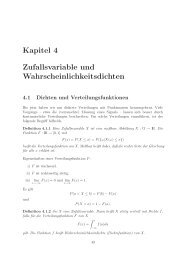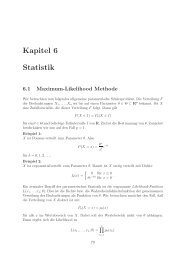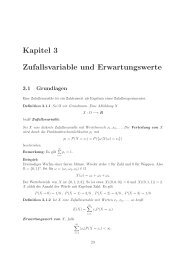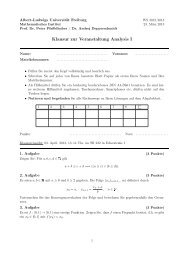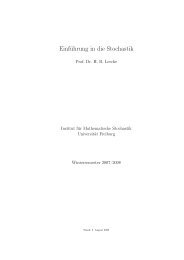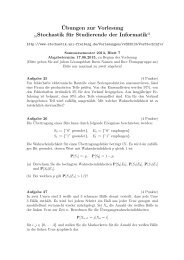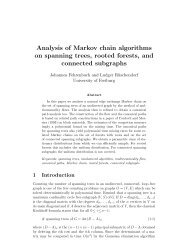On the Internal Path Length of dâdimensional Quad Trees
On the Internal Path Length of dâdimensional Quad Trees
On the Internal Path Length of dâdimensional Quad Trees
You also want an ePaper? Increase the reach of your titles
YUMPU automatically turns print PDFs into web optimized ePapers that Google loves.
By calculation as in <strong>the</strong> pro<strong>of</strong> <strong>of</strong> Lemma 3.2<br />
⎛<br />
⎞<br />
IEC 2 (〈U〉) = −1 + 4 2<br />
d IE ∑<br />
d −1<br />
⎝ 〈U〉 2 i ln〈U〉 i<br />
⎠<br />
= −1 + 4 2∑<br />
d −1<br />
d 2<br />
i,j=0<br />
i=0<br />
IE[〈U〉 i 〈U〉 j ln〈U〉 i ln〈U〉 j ].<br />
The distribution <strong>of</strong> <strong>the</strong> factors 〈U〉 i 〈U〉 j ln〈U〉 i ln〈U〉 j only depends on <strong>the</strong><br />
number <strong>of</strong> digits in which <strong>the</strong> dual representations <strong>of</strong> i and j differ (see (5),<br />
(6)). Therefore<br />
⎛<br />
⎞<br />
2∑<br />
d −1<br />
IE ⎝ 〈U〉 i ln〈U〉 i<br />
⎠<br />
i=0<br />
2<br />
2<br />
( )<br />
d∑ d<br />
= 2 d l h . (45)<br />
h=0<br />
h<br />
l h can be calculated by first applying <strong>the</strong> functional equation <strong>of</strong> <strong>the</strong> logarithm.<br />
This yields d 2 terms <strong>of</strong> <strong>the</strong> form<br />
d−h ∏ d∏<br />
u<br />
∫[0,1] 2 d i<br />
i=1 i=d−h+1<br />
(u i (1 − u i )) ln ũ k ln ũ l dλ d (u)<br />
with ũ k = u k for k ≤ d − h and ũ k = 1 − u k for k > d − h. Then distinguish<br />
<strong>the</strong> cases 1 ≤ k, l ≤ d − h and d − h + 1 ≤ k, l ≤ d for k = l and k ≠ l<br />
and finally 1 ≤ k ≤ d − h < l ≤ d. The arising integrals can be calculated<br />
elementary. This implies <strong>the</strong> representation<br />
( ( 2 d<br />
) −1 [<br />
v d = 1 − −1 +<br />
3) 4 ( ) 2 d d∑<br />
( ) (1 d h<br />
]<br />
s<br />
d 2 h<br />
3<br />
h=0<br />
h 2)<br />
(46)<br />
where<br />
s h =<br />
( d<br />
3 − h 2<br />
) 2<br />
+ d ( ) 5<br />
9 + 4 − π2<br />
h.<br />
6<br />
Now a simplification with <strong>the</strong> help <strong>of</strong> Maple leads to <strong>the</strong> stated variance.<br />
l 2 -convergence implies convergence <strong>of</strong> second order moments. We obtain as<br />
Corollary <strong>the</strong> first order asymptotics <strong>of</strong> <strong>the</strong> variance <strong>of</strong> <strong>the</strong> internal path<br />
length Y n .<br />
14


